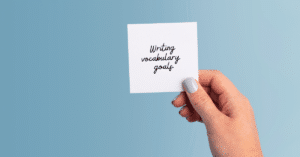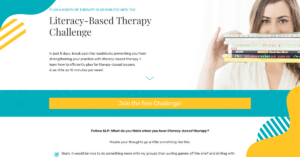How can I possibly target all of my students’ goal in one speech therapy session? Johnny is working on describing and past tense verbs. Chloe has goals to use pronouns and answer WH questions. Zach is working on multiple meaning words and compound sentences. Yikes! Those mixed groups seem tricky, don’t they?
They don’t have to be!
You can check out the video (above) for a walkthrough of my “system.”
Want a quick overview? Scroll down to read more!
Why Pocket Charts?
I was reading a lot about literacy-based therapy. I read a lot of articles, and the second chapter in Ukrainetz’s book (Contextualized Language Intervention) was what helped me piece everything together. Ronald B. Gillam and Teresa Ukrainetz shared a five-step “protocol” for literacy-based therapy.
Want to learn more about the five steps? Check out the book or the webinar in the SLP Now Membership for a closer look!
Now that I had a framework, I started trying to think of a way to actually implement this in therapy. I knew I needed…
– something visual, making it easy to scaffold a variety of skills (e.g., articulation, grammar, language, pragmatics).
– something simple, so I wouldn’t have to spend hours prepping for every unit.
– something versatile, with the ability to target basic levels (e.g., drill-based practice), as well as the ability to build up to larger skills (e.g., generating a narrative).
I was observing in a classroom where the teacher happened to be using a pocket chart to organize her sentence strips. The rest is history!
After some fine tuning, I was able to use a pocket chart to target my students’ goals in a visual, simple, and versatile way.
Here are examples of the materials I used:
The Process
Now, let’s chat about how we can use the pocket chart in therapy!
NOTE: You’ll want to make sure your students are aware of their goals before jumping into using a pocket chart in therapy.
Step 1: Create Cards
We have two options here!
1. We can use index cards and write on words.
2. I created templates for the parts of speech (e.g., conjunctions, prepositions, etc.) and for vocabulary words (to guide students when defining the words). You can find these tools in the SLP Now Membership!
Ideally, we would involve students in as much of the process as possible. Stay tuned for more tips!
Step 2: Practice
This may happen before/during/after the actual book reading.
What does this actually look like?
- Check out the video at the top of this post for some general suggestions.
- I shared some ideas for grammar intervention.
- I am working on more detailed posts/videos for a variety of target areas!
Step 3: Build Up
After repeated opportunities for practice, we’ll start building up. Students will start to combine sentences to retell the story and/or generate parallel stories.
The best part? We already have visuals on hand to scaffold these skills! We can use the target cards/sentence strips to support our students as they begin to use their new skills in an embedded context.
Want to learn more? Stay tuned for more blog posts with more specific activity ideas.




do you sell the parts of speech cards you have in your pocket chart?
Yes! They’re in the SLP Now Membership!
What is the link for the pocket chart, I went to amazon but there are sooooooo many?
Here you are, Ginny! http://amzn.to/2EBzJVV (affiliate link)
I watched your video and really excited to implement the pocket chart this year! A few clarifications:
Do you pre-select the nouns, verbs, prepositions (whatever your students are working on), and then when they hear it or find it in the book, do they write it down? Do you have it already written down for them? Thank you!
Great question, Nina! It really depends on the group! I’ve done both! 🙂
Thank you!